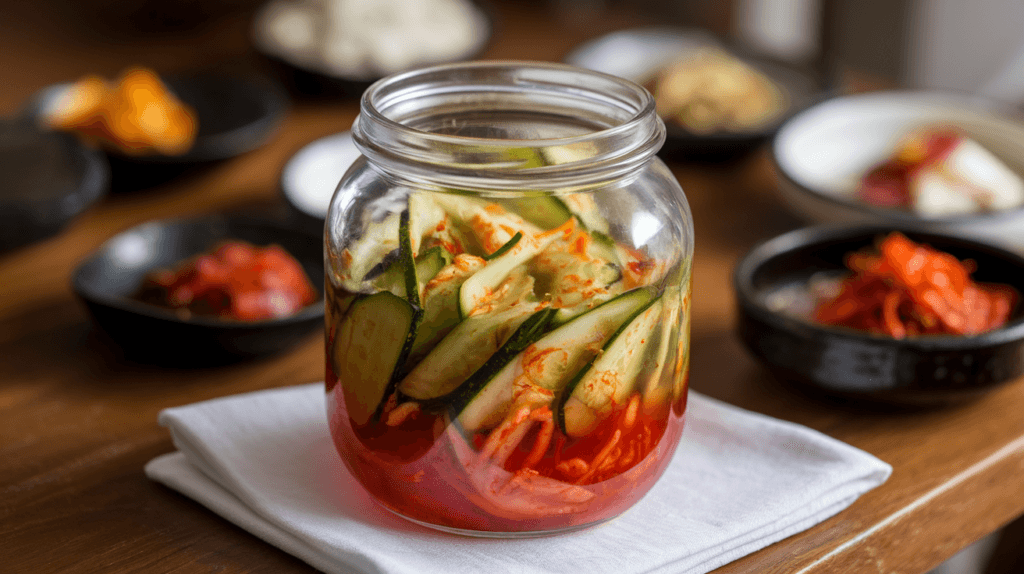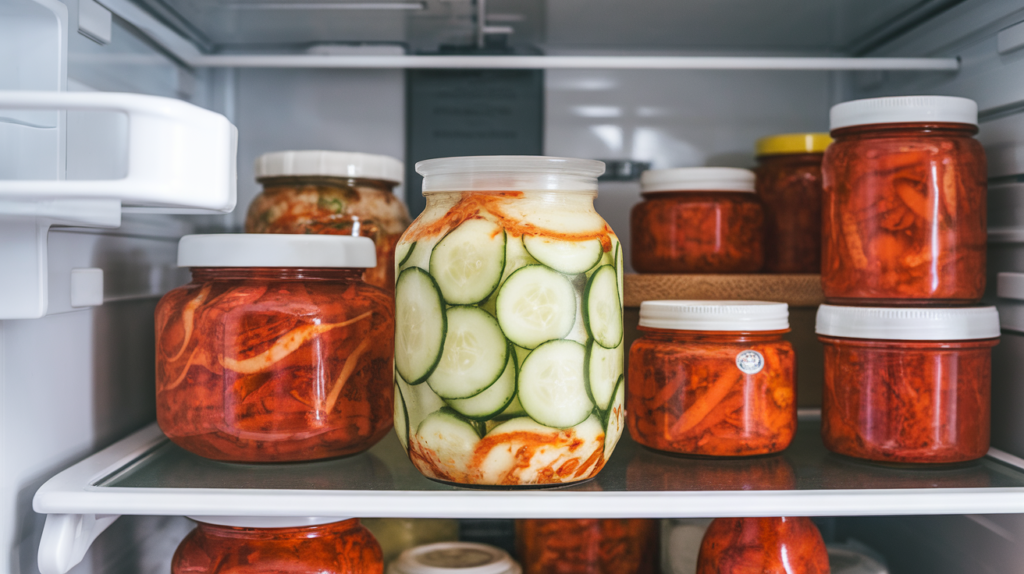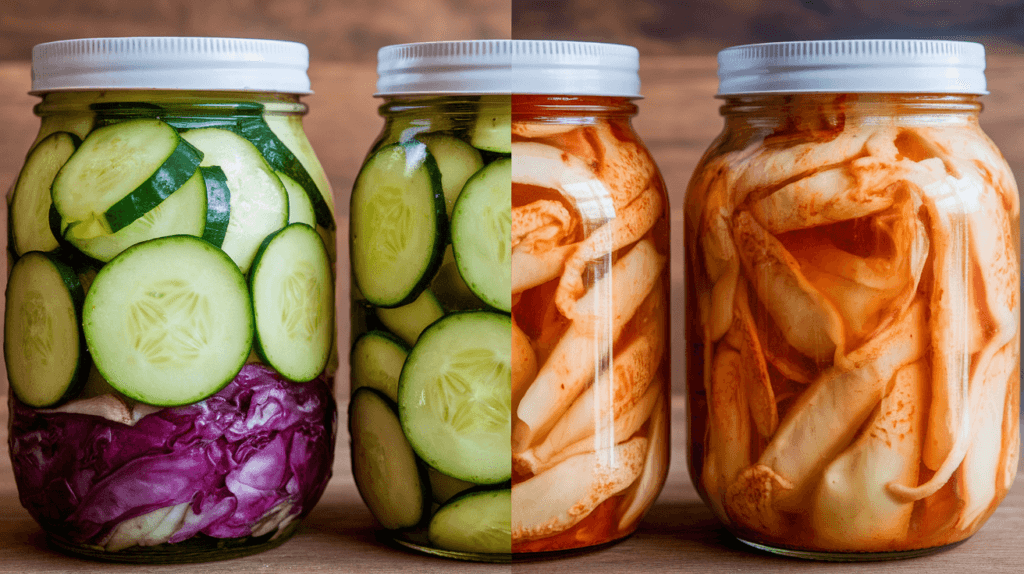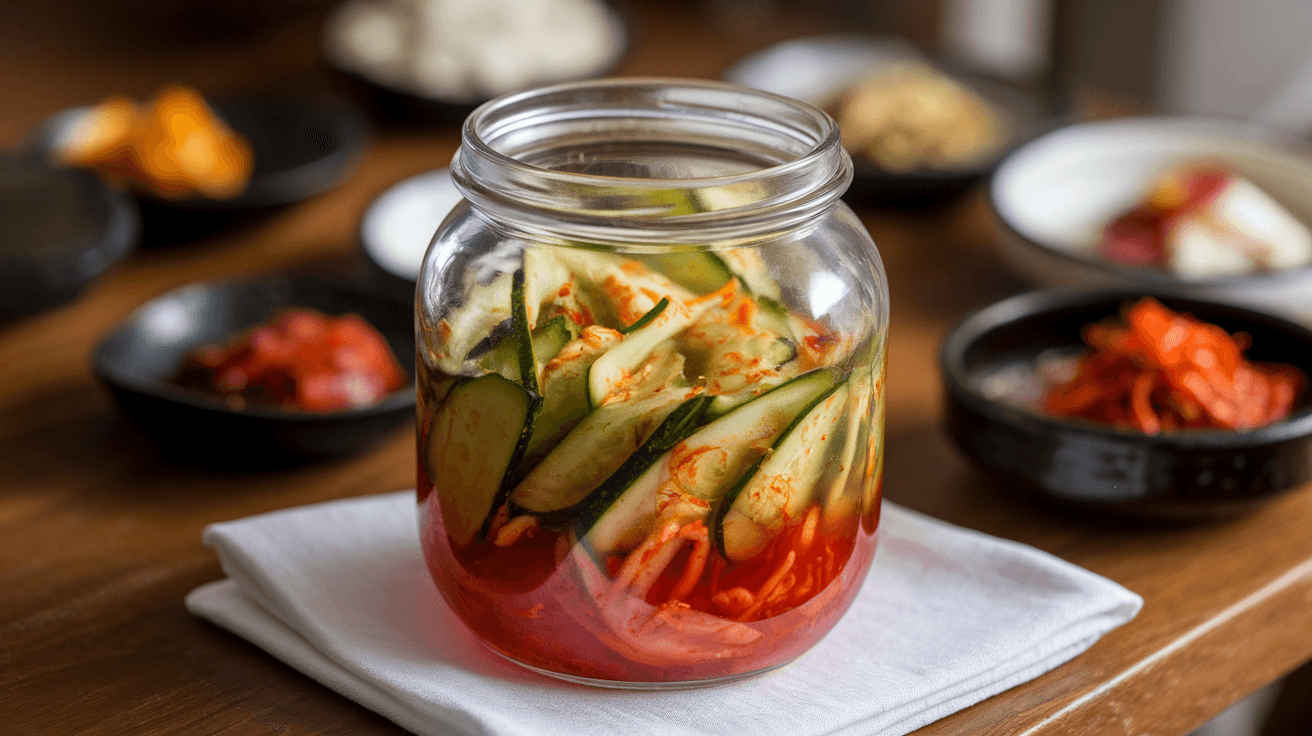Introduction

Cucumber kimchi is a beloved variation of traditional Korean kimchi, offering a fresh and crunchy twist to the fermented classic. Known for its tangy flavor and spicy kick, cucumber kimchi is a delightful side dish that pairs well with many meals. But how long will cucumber kimchi last in the fridge? Understanding its shelf life is crucial to maintain its flavor, texture, and safety.
Understanding how long cucumber kimchi lasts in the fridge is crucial not only for maintaining its taste and texture but also for ensuring food safety. In this article, we’ll dive deep into the factors that influence its shelf life, how to store it properly, and how to identify when it’s time to toss it out. Let’s begin!
Factors Affecting Shelf Life
Key Ingredients in Cucumber Kimchi
The ingredients used in cucumber kimchi play a significant role in determining its shelf life. Traditional cucumber kimchi contains cucumbers, garlic, chili powder, salt, and sometimes fish sauce or shrimp paste. The high salt content and acidic nature of these ingredients help preserve the kimchi by creating an environment that inhibits harmful bacterial growth. But how long will cucumber kimchi last in the fridge? The answer depends on how these ingredients interact during storage and fermentation.
However, the type and freshness of the cucumbers themselves can also impact the longevity of the dish. Fresh cucumbers with firm texture and minimal bruising are essential for making a kimchi that lasts longer in the fridge. Additionally, if the kimchi includes seafood-based ingredients like fish sauce or shrimp paste, it may have a slightly shorter shelf life compared to purely plant-based versions.
The Role of Fermentation and Temperature
Fermentation is the heart of any kimchi recipe. During fermentation, lactic acid bacteria thrive, creating a tangy flavor while preserving the dish. The fermentation process continues even after the kimchi is stored in the fridge, albeit at a much slower rate. But how long will cucumber kimchi last in the fridge? This largely depends on the balance of fermentation and storage conditions. Over time, the kimchi’s flavor will evolve, becoming sourer as it ferments further.
Temperature plays a critical role in this process. While refrigeration slows down fermentation and extends the shelf life, storing cucumber kimchi at temperatures above 40°F (4°C) can accelerate spoilage. Properly refrigerated kimchi can typically last between 2 to 3 weeks without losing quality, although this varies based on storage conditions and ingredient freshness.
Proper Storage Techniques

Best Practices for Storing Cucumber Kimchi in the Fridge
Proper storage is essential to maximize the shelf life of cucumber kimchi while maintaining its flavor and safety. Here are some best practices to follow:
- Keep it cold: Store your cucumber kimchi in the refrigerator at a consistent temperature below 40°F (4°C). Avoid temperature fluctuations, as they can hasten spoilage.
- Use a dedicated spot: Place the kimchi in the coldest section of the fridge, typically near the back, to ensure it stays fresh for as long as possible.
- Avoid cross-contamination: Always use clean utensils when scooping out kimchi to prevent introducing bacteria or other contaminants.
Container Selection and Airtight Seals
The container you choose for storing cucumber kimchi is just as important as the refrigeration process. Proper storage containers can significantly extend its shelf life:
- Glass jars: Glass containers are ideal for storing cucumber kimchi. They are non-reactive and prevent unwanted flavors from leaching into the kimchi.
- Airtight lids: Ensure the jar or container has a tightly sealing lid to minimize air exposure. Less oxygen slows down fermentation and reduces the risk of spoilage.
- Avoid plastic bags: While plastic containers can be used, avoid using plastic bags as they may not be durable enough to contain the kimchi’s juices and odors.
Proper sealing also prevents the kimchi’s distinct aroma from spreading to other foods in the fridge. Make sure the lid is tightly secured after each use to keep the kimchi fresh and flavorful for an extended period.
Signs of Spoiled Cucumber Kimchi

How to Identify Spoiled Kimchi
Although cucumber kimchi is a fermented food designed to last for weeks, it can eventually spoil if not stored correctly or consumed within the recommended timeframe. Recognizing the signs of spoiled kimchi is essential to avoid consuming unsafe food. Here’s what to look for:
- Unusual odor: While kimchi naturally has a strong, tangy smell, a foul or overly pungent odor could indicate spoilage.
- Off taste: Spoiled kimchi may taste excessively sour or bitter, with an unpleasant aftertaste that doesn’t align with its normal flavor profile.
- Texture changes: If the cucumbers become excessively slimy or mushy, it’s a clear sign that the kimchi is no longer fresh.
Common Visual and Olfactory Cues
Visual inspection can also help determine if your cucumber kimchi is past its prime. Be on the lookout for:
- Discoloration: Kimchi that develops black, grey, or green spots may have mold and should be discarded immediately.
- Bubbles or excessive gas: While some bubbling is natural due to fermentation, excessive gas buildup or an unusually swollen container could mean the kimchi is over-fermented or spoiled.
- Separation of liquid: If a large amount of liquid separates from the solids and the color changes significantly, it’s a sign that the fermentation process has gone too far.
If you notice any of these signs, it’s best to err on the side of caution and discard the kimchi. Consuming spoiled kimchi can lead to foodborne illnesses, so always prioritize safety.
Extending the Shelf Life
Tips for Preserving Cucumber Kimchi
While cucumber kimchi naturally has a limited shelf life compared to other types of kimchi, there are several methods to keep it fresh and delicious for as long as possible:
- Adjust the salt content: Using slightly more salt during the preparation process can help slow down fermentation and prevent spoilage.
- Maintain consistent refrigeration: Ensure the kimchi is stored at a constant cold temperature to inhibit the growth of harmful bacteria.
- Smaller portions: Divide the kimchi into smaller containers to reduce air exposure each time you open a jar or container.
Freezing vs Refrigeration
For those looking to extend the shelf life of cucumber kimchi significantly, freezing is an option, although it comes with trade-offs:
- Freezing: Freezing cucumber kimchi can halt fermentation altogether, preserving its flavor and texture for up to three months. However, freezing may slightly alter the texture of the cucumbers, making them less crunchy.
- Refrigeration: Refrigeration slows fermentation and retains the kimchi’s original taste and texture but limits shelf life to about two to three weeks.
To freeze cucumber kimchi, place it in a freezer-safe container, leaving a small amount of headspace to allow for expansion. When you’re ready to use it, thaw the kimchi in the refrigerator for several hours or overnight to ensure a gradual temperature transition.
Fermentation Control
Another way to extend shelf life is to control the fermentation process. If you prefer a milder flavor, refrigerate the kimchi immediately after preparation to slow fermentation. For those who enjoy a stronger taste, allow it to ferment at room temperature for a day or two before transferring it to the fridge.
By following these tips, you can enjoy your cucumber kimchi for an extended period without sacrificing quality or safety.
Health Benefits of Cucumber Kimchi
Rich in Probiotics
Cucumber kimchi, like other fermented foods, is a great source of probiotics. These beneficial bacteria help improve gut health, enhance digestion, and boost the immune system. But how long will cucumber kimchi last in the fridge while retaining its probiotic benefits? Regular consumption of probiotic-rich foods like kimchi can contribute to a balanced gut microbiome, which is linked to overall well-being.
Low in Calories and High in Nutrients
One of the reasons cucumber kimchi is so popular is its nutritional profile. It’s naturally low in calories, making it an excellent choice for those looking to maintain or lose weight. Additionally, it’s packed with vitamins and minerals, including:
- Vitamin A: Essential for healthy vision and skin.
- Vitamin C: Supports the immune system and helps with collagen production.
- Potassium: Helps regulate blood pressure and maintain electrolyte balance.
Anti-Inflammatory Properties
The ingredients in cucumber kimchi, such as garlic and chili powder, contain compounds with anti-inflammatory properties. These compounds can help reduce inflammation in the body and may contribute to better cardiovascular health and reduced risk of chronic diseases.
Supports Metabolic Health
Fermented foods like cucumber kimchi have been shown to support metabolic health. They may help regulate blood sugar levels and promote healthier cholesterol profiles. Adding cucumber kimchi to your meals can be a flavorful way to enhance your diet’s overall health benefits.
Hydration and Detoxification
Thanks to the high water content of cucumbers, cucumber kimchi is naturally hydrating. It also contains antioxidants that help combat free radicals, promoting cellular health and aiding the body’s detoxification processes.
With its combination of probiotics, nutrients, and health-promoting ingredients, cucumber kimchi is more than just a tasty side dish—it’s a functional food that supports your body from the inside out.
How the Fermentation Process Works in Cucumber Kimchi
The Science Behind Fermentation
Fermentation is the process that gives cucumber kimchi its distinct tangy flavor and extended shelf life. This process occurs when natural or added bacteria break down sugars in the cucumbers and other ingredients, producing lactic acid. This lactic acid acts as a preservative, preventing the growth of harmful bacteria and enhancing the kimchi’s safety and flavor.
Key Stages of Fermentation
There are several stages in the fermentation process of cucumber kimchi, each contributing to its taste and texture:
- Initial Stage: Fresh cucumbers and seasoning ingredients are combined. During this stage, salt draws out moisture, softens the cucumbers, and creates an environment where beneficial bacteria can thrive.
- Active Fermentation: Over the next 1-2 days, bacteria such as Lactobacillus multiply, converting natural sugars into lactic acid. This stage is when the tangy flavor starts to develop.
- Slower Fermentation: Once the kimchi is placed in the fridge, fermentation continues at a much slower rate, allowing flavors to mature gradually without spoilage.
Temperature’s Role in Fermentation
Temperature is a critical factor in the fermentation process. If cucumber kimchi is left at room temperature for too long, fermentation may accelerate uncontrollably, leading to over-souring or spoilage. Refrigeration slows down this process, helping the kimchi maintain its crisp texture and balanced flavor for a longer period.
How Fermentation Enhances Flavor
Fermentation not only preserves cucumber kimchi but also enriches its flavor. The process brings out complex, savory notes, often referred to as umami, which makes kimchi a favorite in many cuisines worldwide. With time, the taste evolves, becoming tangier and more robust, making it versatile for different culinary applications.
Understanding how fermentation works in cucumber kimchi can help you manage its storage and flavor profile, ensuring you get the most out of this delicious dish.
Frequently Asked Questions (FAQs)
1. Can cucumber kimchi go bad quickly?
Yes, cucumber kimchi can spoil more quickly than other types of kimchi due to the high water content of cucumbers. This makes them more prone to softening and spoilage, especially if not stored properly. Keeping it refrigerated in an airtight container can slow this process.
2. How can you tell if cucumber kimchi is safe to eat?
Check for any signs of spoilage, such as an unpleasant odor, discolored or moldy spots, or a slimy texture. If the kimchi smells and looks normal and tastes sour without being overly pungent, it’s likely safe to eat.
3. Can you freeze cucumber kimchi?
Yes, freezing is an option to extend the shelf life of cucumber kimchi. While freezing can slightly alter the texture of the cucumbers, it preserves the flavor and prevents further fermentation. Always use a freezer-safe container for best results.
4. How long does cucumber kimchi last once opened?
Once opened, cucumber kimchi typically lasts around 2 to 3 weeks in the refrigerator, provided it is stored in an airtight container and at the proper temperature.
5. Is it safe to eat over-fermented cucumber kimchi?
Over-fermented cucumber kimchi is usually safe to eat as long as there are no signs of spoilage like mold or foul odors. However, the flavor may be more sour than some people prefer. It can still be used as an ingredient in soups or stews to balance its tanginess.
6. What’s the best way to store cucumber kimchi long-term?
The best long-term storage option for cucumber kimchi is freezing it in small portions to minimize waste. This approach preserves its flavor and prevents spoilage, making it a practical choice for those who make large batches.
Conclusion
Cucumber kimchi is a delicious and versatile side dish that can be enjoyed for weeks when properly stored in the fridge. By understanding the factors affecting its shelf life, following proper storage techniques, and recognizing the signs of spoilage, you can ensure your kimchi remains safe and flavorful.
If you need an even longer storage option, freezing cucumber kimchi is a viable alternative, though it may slightly alter its texture. With these tips, you can savor the vibrant taste of cucumber kimchi while minimizing waste and maximizing enjoyment.

